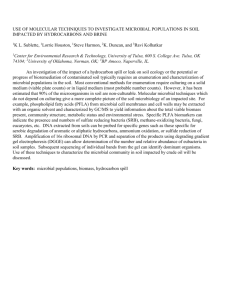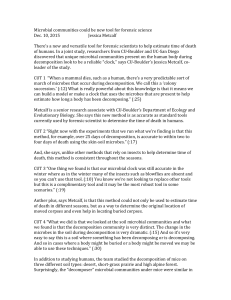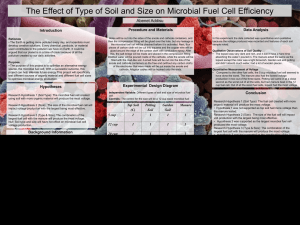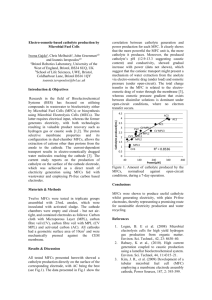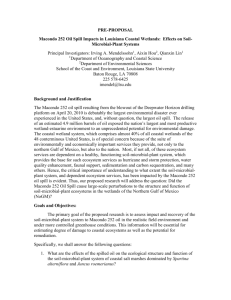Optimizing the Microbial Fuel Cell as an Alternative Fossil Fuel Source
advertisement
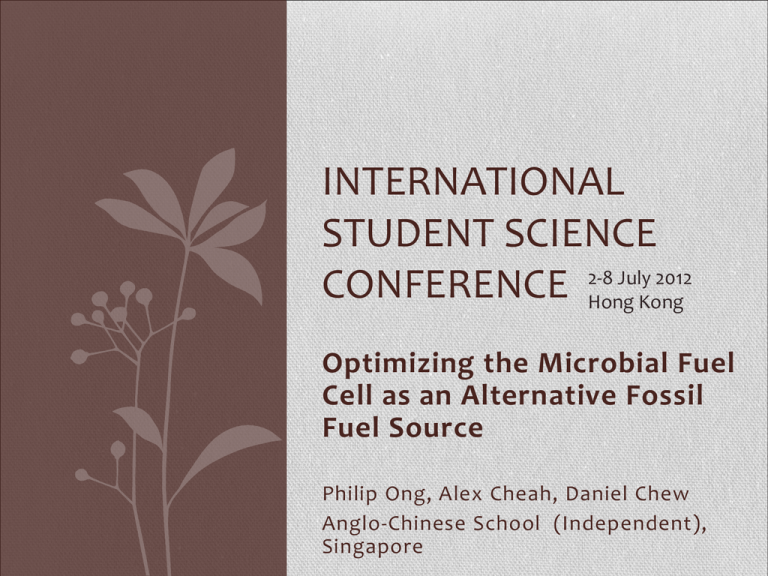
INTERNATIONAL STUDENT SCIENCE July 2012 CONFERENCE 2-8 Hong Kong Optimizing the Microbial Fuel Cell as an Alternative Fossil Fuel Source Philip Ong, Alex Cheah, Daniel Chew Anglo-Chinese School (Independent), Singapore Introduction – The Microbial Fuel Cell •A bio-electrochemical system that uses bacteria to produce electricity •Converts chemical energy to electrical energy by catalytic reaction of microorganisms •Used to generate electricity for storage Our Aims • Curbing carbon emissions by offering a cheap, efficient method of obtaining energy • To conserve fossil fuels and oil • To reduce the emissions of environmentallyunfriendly substances into the earth Our Set-Up • Our experiment involved the use of a soil-based Microbial Fuel Cell (MFC) through the construction of a Winogradsky Column. • Variables: • [Independent]: Salinity as controlled by the amount of NaCl per set-up • [Dependent]: Current (in miliamperes) • [Controlled]: Temperature, Location, Container Size & Shape, Type of electrode, Amount of soil. Materials and Apparatus • Materials: • 1. Clay soil used: 50% clay [Al 2Si2O5(OH)4] 50% soil [SiO2] • (400g per set-up) • 2. Sulfur • (50g per set-up) • 3. Water • 4. Newspaper Shreds • (10g per set-up) • • • • • • • 5. NaCl Apparatus: 1. 2 Graphite Electrodes per set-up (as the anode and cathodes) 2. 2 Crocodile Clips 3. Multimeter 4. Stopwatch 5. Plastic containers Conversions Added amount of salt / g 0 5 10 15 20 Added salt concentration / ppm 0 2320 4630 6928 9217 Trend of current output against time 1.4 1.2 Current, I/mA 1 0 0.8 2320 0.6 4630 6928 0.4 9217 0.2 0 1 2 3 4 5 6 7 8 9 10 11 12 13 14 15 16 17 18 19 20 21 Day Last day results 1.6 1.4 Curent, I/mA 1.2 1 0.8 0.6 0.4 0.2 0 0 2000 4000 6000 8000 Added Molar Concentration of NaCl/ppm 10000 Analysis • Increase ionic strength Decrease resistance • I = 1.6 x 10-5 x Specific Conductance (in µmho/cm) • I = ½ Σ zi2 mi • Provide nutrients • Tonicity: Too much salt causes crenation • Lower oxygen levels Limitations • Carbon surfaces not pure • Denitrification of nitrogen containing functionalities • Pt electrodes might oxidize separate substrates • Electroactive chemicals naturally present • Contaminants easily absorbed Conclusion • Optimal range: 4000ppm-7000ppm • Good current output • Renewable energy source • Easily accessible Further Research • Different genera involved • Optimal soil for involvement in MFC • Using other substitutes for soil eg. Wastewater • Research into MFCs as a method of reducing toxicity of soil • Use of Sulfate Reducing Bacteria • Polysulfides to sulfur • Electrochemically active bacteria References • Newton. Oxygen Levels in Salt and Fresh Water. http://www.newton.dep.anl.gov/askasci/chem03/chem03339.htm • U.S. Geological Survey. Saline water. http://ga.water.usgs.gov/edu/saline.html • CaCt. Chemical Reactivity: A Study Guide. http://www.science.uwaterloo.ca/~cchieh/cact/applychem/reactivity.html • University of Massachusetts: College of Engineering. Chapter XVIII: Electrochemical methods. http://www.ecs.umass.edu/cee/reckhow/courses/572/572bk18/572BK18.html • Glass Properties. Definitions: Resistance, Specific resistance (resistivity), Conductance, Specific conductance (conductivity). http://glassproperties.com/resistivity/Conductivity_Resistivity.pdf • Xi Wang et al., Impact of salinity on cathode catalyst performance in microbial fuel cells (MFCs). International Journal of Hydrogen Energy [online] 2011, 36, 1390013906 http://www.engr.psu.edu/ce/enve/logan/publications/2011-Wang-etalIJHE.pdf • Korneel Rabaey et al., Microbial Fuel Cells for Sulfide Removal. Environ. Sci. Technol. [online] 2006, 40, 5218-5224 http://www.microbialfuelcell.org/Publications/LabMET/Rabaey%20Environ%20Sci%2 0Techn%2040%205218-5224%20Sulfide%20removal.pdf

